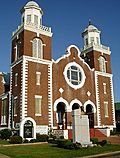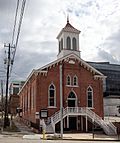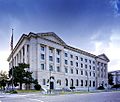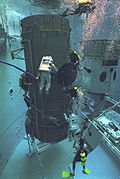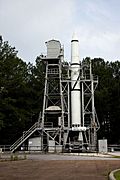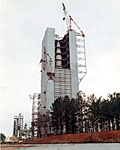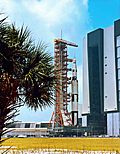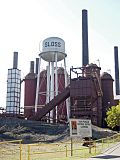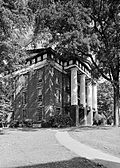List of National Historic Landmarks in Alabama facts for kids
The National Historic Landmarks in Alabama are super special places that tell amazing stories about Alabama's past. Think of them like important chapters in a history book! There are 39 of these landmarks across 18 of Alabama's counties.
These landmarks cover many different parts of history. Some are about the Civil War, others are about the brave people who fought for Civil Rights, and some even show how Alabama helped us explore space! There are also old archaeological sites and cool buildings with unique styles.
The National Park Service, which is part of the U.S. government, helps look after these landmarks. They decide which places are important enough to become an NHL. Being an NHL helps protect these sites so future generations can learn from them.
NHLs are also part of a bigger list called the National Register of Historic Places (NRHP). The main difference is that NHLs are important to the *whole country*, while other NRHP places are important to just the state or local area.
Alabama also has four historic sites managed by the National Park Service. One of them, the Tuskegee Institute National Historic Site, is also a National Historic Landmark.
Contents
Amazing Historic Landmarks in Alabama
Ships and Military History
|- class="vcard" ! style="background-color: #87CEEB;" | 1![]() | USS Alabama
| USS Alabama
(battleship)
|
|
(#86000083)
| class="adr" | Mobile
30°40′49″N 88°00′57″W / 30.6801903657°N 88.015810359°W
| class="note" | The USS Alabama is one of only two South Dakota-class battleships still around. It was used in World War II for over three years, fighting in the Pacific Ocean and earning nine battle stars for its bravery.
|- class="vcard" ! style="background-color: #87CEEB;" | 11![]() | USS Drum
| USS Drum
(submarine)
|
|
(Ref. # missing)
| class="adr" | Mobile
30°40′44″N 88°01′00″W / 30.678830496°N 88.0166312697°W
| class="note" | The USS Drum was the very first Gato-class submarine built before World War II. It was a key design for American submarines at the start of the war. This submarine sank fifteen Japanese ships and earned twelve battle stars.
|- class="vcard" ! style="background-color: #87CEEB;" | 23![]() | Montgomery (snagboat)
| Montgomery (snagboat)
|
|
(Ref. # missing)
| class="adr" | Pickensville
33°13′26″N 88°15′36″W / 33.2238°N 88.2599°W
| class="note" | The Montgomery is one of the few steam-powered sternwheelers left in the United States. Built in 1925, it helped build the important Alabama–Tombigbee–Tennessee River Project.
Ancient Sites and Early Settlements
|- class="vcard" ! style="background-color: #87CEEB;" | 2![]() | Apalachicola Fort
| Apalachicola Fort
|
|
(#66000931)
| class="adr" | Holy Trinity
32°10′17″N 85°07′49″W / 32.17134°N 85.13023°W
| class="note" | Spain built this fort on the Chattahoochee River in 1690 to keep good relations with the Apalachicola people. It was used for only one year before the Spanish left and destroyed it.
|- class="vcard" ! style="background-color: #87CEEB;" | 5![]() | Bottle Creek Site
| Bottle Creek Site
|
|
(#74000398)
| class="adr" | Stockton
30°59′44″N 87°56′16″W / 30.995555555555555°N 87.9376388888889°W
| class="note" | This archaeological site has eighteen large mounds built by the Mississippian culture between AD 1250 and 1550. It was likely a major center for social life, religion, and trade in the Mobile Delta area.
|- class="vcard" ! style="background-color: #87CEEB;" | 14![]() | Fort Mitchell Site
| Fort Mitchell Site
|
|
(#72000178)
| class="adr" | Fort Mitchell
32°21′07″N 85°01′18″W / 32.35194444444445°N 85.02166666666666°W
| class="note" | Fort Mitchell tells the story of how the U.S. interacted with Native Americans. It shows how the Creek Nation lost their land and how the government tried to keep its promises.
|- class="vcard" ! style="background-color: #87CEEB;" | 15![]() | Fort Morgan
| Fort Morgan
|
|
(#66000146)
| class="adr" | Gasque
30°13′41″N 88°01′23″W / 30.228055555555553°N 88.02305555555556°W
| class="note" | Fort Morgan was finished in 1834. It was used by Confederate forces during the Battle of Mobile Bay in the Civil War. This battle was important because the Union Navy took control of Mobile Bay.
|- class="vcard" ! style="background-color: #87CEEB;" | 16![]() | Fort Toulouse Site-Fort Jackson
| Fort Toulouse Site-Fort Jackson
|
|
(#66000148)
| class="adr" | Wetumpka
32°30′24″N 86°15′06″W / 32.506619°N 86.251569°W
| class="note" | Fort Toulouse was a French outpost built in 1717. It was abandoned in 1763. Later, Andrew Jackson built a new fort here in 1814 after defeating the Creek Nation.
|- class="vcard" ! style="background-color: #87CEEB;" | 25![]() | Moundville Site
| Moundville Site
|
|
(#66000149)
| class="adr" | Moundville
33°00′17″N 87°37′52″W / 33.00467°N 87.63107°W
| class="note" | Moundville was first settled around the year 900. It was a very important center for the Mississippian culture and the second largest site of its kind, after Cahokia in Illinois.
|- class="vcard" ! style="background-color: #87CEEB;" | 39![]() | Yuchi Town Site
| Yuchi Town Site
|
|
(#95000453)
| class="adr" | Fort Benning
32°18′00″N 84°59′00″W / 32.3°N 84.9833°W
| class="note" | This archaeological site was home to the Apalachicola and Yuchi tribes. They often changed their alliances with European powers until they were moved by the expanding American frontier in the early 1800s.
Civil Rights Movement Landmarks
|- class="vcard" ! style="background-color: #87CEEB;" | 4![]() | Bethel Baptist Church, Parsonage, and Guard House
| Bethel Baptist Church, Parsonage, and Guard House
|
|
(#05000455)
| class="adr" | Birmingham
33°33′07″N 86°48′07″W / 33.551806°N 86.802028°W
| class="note" | This church was a main meeting place for the Alabama Christian Movement for Human Rights from 1956 to 1961. This group worked to end segregation and discrimination in Alabama.
|- class="vcard" ! style="background-color: #87CEEB;" | 6![]() | Brown Chapel A.M.E. Church
| Brown Chapel A.M.E. Church
|
|
(#82002009)
| class="adr" | Selma
32°24′43″N 87°00′58″W / 32.411869°N 87.016053°W
| class="note" | This church was the starting point for the famous Selma to Montgomery marches in 1965. These marches helped lead to the Voting Rights Act of 1965, which protected the right to vote for all Americans.
|- class="vcard" ! style="background-color: #87CEEB;" | 10![]() | Dexter Avenue Baptist Church
| Dexter Avenue Baptist Church
|
|
(#74000431)
| class="adr" | Montgomery
32°22′39″N 86°18′11″W / 32.377473°N 86.303146°W
| class="note" | Martin Luther King Jr. was the pastor here from 1954 to 1960. The Montgomery bus boycott was organized from this church in 1955, a major event in the Civil Rights Movement.
|- class="vcard" ! style="background-color: #87CEEB;" | 17![]() | Foster Auditorium
| Foster Auditorium
|
|
(#05000457)
| class="adr" | Tuscaloosa
33°12′28″N 87°32′38″W / 33.20777777777778°N 87.54388888888889°W
| class="note" | In 1963, Vivian Malone was escorted past Alabama governor George C. Wallace here during the "Stand In The Schoolhouse Door" event. This was a key moment in ending segregation at the University of Alabama.
|- class="vcard" ! style="background-color: #87CEEB;" | 27![]() | Edmund Pettus Bridge
| Edmund Pettus Bridge
|
|
(#13000281)
| class="adr" | Selma
32°24′20″N 87°01′07″W / 32.405556°N 87.018611°W
| class="note" | This bridge was the site of "Bloody Sunday" during the 1965 Selma to Montgomery marches. This event helped lead to the passage of the Voting Rights Act.
|- class="vcard" ! style="background-color: #87CEEB;" | 33![]() | 16th Street Baptist Church
| 16th Street Baptist Church
|
|
(#80000696)
| class="adr" | Birmingham
33°31′00″N 86°48′53″W / 33.51658°N 86.81481°W
| class="note" | This church was a meeting place for Civil Rights marches. Sadly, it was bombed by the Ku Klux Klan in 1963, killing four young girls.
|- class="vcard" ! style="background-color: #87CEEB;" | 36§ | Tuskegee Institute National Historic Site
|
|
(#66000151)
| class="adr" | Tuskegee
32°25′49″N 85°42′28″W / 32.4303°N 85.7078°W
| class="note" | Tuskegee University was founded by Booker T. Washington in 1881. It became one of the most famous African American universities in the U.S., with educators like George Washington Carver.
|- class="vcard" ! style="background-color: #87CEEB;" | 37![]() | United States Post Office and Courthouse–Montgomery
| United States Post Office and Courthouse–Montgomery
|
|
(#98000611)
| class="adr" | Montgomery
32°22′30″N 86°18′34″W / 32.3750°N 86.3095°W
| class="note" | Many important Civil Rights cases, including those related to the Montgomery bus boycott, were heard in this building, built in 1933.
Space Exploration Landmarks
|- class="vcard" ! style="background-color: #87CEEB;" | 26![]() | Neutral Buoyancy Space Simulator
| Neutral Buoyancy Space Simulator
|
|
(#85002807)
| class="adr" | Huntsville
34°39′07″N 86°40′41″W / 34.652006°N 86.678076°W
| class="note" | This huge tank, built in 1955, helped engineers and astronauts practice working in a zero-gravity environment, like space! It was super important for programs like Project Gemini, the Apollo program, and the Space Shuttle.
|- class="vcard" ! style="background-color: #87CEEB;" | 28![]() | Propulsion and Structural Test Facility
| Propulsion and Structural Test Facility
|
|
(#85002804)
| class="adr" | Huntsville
34°37′25″N 86°39′31″W / 34.623636°N 86.65855°W
| class="note" | Built in 1957, this site was key to developing large rockets and their engines. The powerful Saturn Family of rockets, including the giant Saturn V, was developed here under the leadership of Wernher von Braun.
|- class="vcard" ! style="background-color: #87CEEB;" | 29![]() | Redstone Test Stand
| Redstone Test Stand
|
|
(#76000341)
| class="adr" | Huntsville
34°37′51″N 86°40′00″W / 34.630872°N 86.666593°W
| class="note" | This test stand, built in 1953, is the oldest at the Marshall Space Flight Center. It was vital for developing the rockets that launched the first U.S. satellite and the first American into space!
|- class="vcard" ! style="background-color: #87CEEB;" | 31![]() | Saturn V Dynamic Test Stand
| Saturn V Dynamic Test Stand
|
|
(#85002806)
| class="adr" | Huntsville
34°37′45″N 86°39′40″W / 34.6291°N 86.6611°W
| class="note" | Built in 1964, this stand was used to test the fully assembled Saturn V rocket. It helped engineers find and fix problems before the rockets launched into space.
|- class="vcard" ! style="background-color: #87CEEB;" | 32![]() | Saturn V Dynamic Test Vehicle
| Saturn V Dynamic Test Vehicle
|
|
(#78000500)
| class="adr" | Huntsville
34°42′30″N 86°39′21″W / 34.7082°N 86.6558°W
| class="note" | This was the very first Saturn V rocket ever built! It was used for testing the ground facilities at the Marshall Space Flight Center before real missions.
Historic Buildings and Homes
|- class="vcard" ! style="background-color: #87CEEB;" | 3![]() | Barton Hall
| Barton Hall
|
|
(#73000337)
| class="adr" | Cherokee
34°45′03″N 88°00′12″W / 34.7507218719°N 88.0033412413°W
| class="note" | Built in 1840, this plantation house is a beautiful example of Greek Revival architecture. It has a unique stairway that leads to an observatory on the roof!
|- class="vcard" ! style="background-color: #87CEEB;" | 7![]() | City Hall
| City Hall
|
|
(#69000034)
| class="adr" | Mobile
30°41′24″N 88°02′24″W / 30.689979°N 88.040106°W
| class="note" | Mobile's Old City Hall, finished in 1857, shows how buildings in the 1800s were designed to serve many purposes for the community. It's built in the Italianate style.
|- class="vcard" ! style="background-color: #87CEEB;" | 8![]() | Henry D. Clayton House
| Henry D. Clayton House
|
|
(#76002259)
| class="adr" | Clayton
31°51′56″N 85°27′09″W / 31.86561111111111°N 85.45236111111112°W
| class="note" | This was the home of Henry De Lamar Clayton, Jr., who wrote the Clayton Antitrust Act. This law helped make sure businesses competed fairly. He also worked to improve the justice system.
|- class="vcard" ! style="background-color: #87CEEB;" | 9![]() | J.L.M. Curry Home
| J.L.M. Curry Home
|
|
(#66000154)
| class="adr" | Talladega
33°27′21″N 86°02′40″W / 33.45583333333334°N 86.04444444444444°W
| class="note" | This was the home of Jabez Lamar Monroe Curry, an important educator. He helped expand and improve public schools and teacher training schools across the South.
|- class="vcard" ! style="background-color: #87CEEB;" | 12![]() | Episcopal Church of the Nativity
| Episcopal Church of the Nativity
|
|
(#74000420)
| class="adr" | Huntsville
34°43′49″N 86°35′03″W / 34.730189°N 86.584050°W
| class="note" | Built in 1859, this Gothic Revival church is one of the best examples of church architecture in the South. It was designed by the famous architect Frank Wills.
|- class="vcard" ! style="background-color: #87CEEB;" | 13![]() | First Confederate Capitol
| First Confederate Capitol
|
|
(#66000152)
| class="adr" | Montgomery
32°22′33″N 86°18′03″W / 32.3757427702°N 86.3009395655°W
| class="note" | In 1861, leaders from six Southern states met here to form the Confederate States of America. Jefferson Davis became their president on the steps of this building.
|- class="vcard" ! style="background-color: #87CEEB;" | 18![]() | Gaineswood
| Gaineswood
|
|
(#72000167)
| class="adr" | Demopolis
32°30′31″N 87°50′07″W / 32.508726°N 87.835239°W
| class="note" | This Greek Revival mansion is considered one of the most unique examples of its style in the U.S. It was built over 18 years by Nathan Bryan Whitfield and features different types of Greek columns.
|- class="vcard" ! style="background-color: #87CEEB;" | 19![]() | Government Street Presbyterian Church
| Government Street Presbyterian Church
|
|
(#92001885)
| class="adr" | Mobile
30°41′21″N 88°02′39″W / 30.689153°N 88.044151°W
| class="note" | Built in 1836, this church is one of the oldest and best-preserved Greek Revival churches in the United States. It was designed by famous architects James Gallier and James and Charles Dakin.
|- class="vcard" ! style="background-color: #87CEEB;" | 20![]() | Ivy Green
| Ivy Green
|
|
(#70000101)
| class="adr" | Tuscumbia
34°44′22″N 87°42′24″W / 34.739444444444445°N 87.70666666666666°W
| class="note" | This is the home where deaf and blind Helen Keller was born. It's where she learned to communicate with the help of her amazing teacher, Anne Sullivan.
|- class="vcard" ! style="background-color: #87CEEB;" | 21![]() | Kenworthy Hall
| Kenworthy Hall
|
|
(#90001318)
| class="adr" | Marion
32°38′06″N 87°21′07″W / 32.6351°N 87.352°W
| class="note" | This plantation house, finished in 1860, is a great example of Richard Upjohn's unique Italian villa style. It was designed to fit the Southern climate and plantation life.
|- class="vcard" ! style="background-color: #87CEEB;" | 22![]() | Monroe County Courthouse
| Monroe County Courthouse
|
|
(#100006236)
| class="adr" | Courthouse Sq.
31°31′38″N 87°19′27″W / 31.5271°N 87.3243°W
| class="note" | This 1903 courthouse is famous for its connection to writers Truman Capote and Harper Lee.
|- class="vcard" ! style="background-color: #87CEEB;" | 24![]() | Montgomery Union Station and Trainshed
| Montgomery Union Station and Trainshed
|
|
(#73000368)
| class="adr" | Montgomery
32°22′43″N 86°18′52″W / 32.3787°N 86.3145°W
| class="note" | Built in 1898, this train station was the main way to travel into Montgomery. Its train shed shows how bridge-building ideas were used to create shelter, which was a big step in American engineering.
|- class="vcard" ! style="background-color: #87CEEB;" | 30![]() | St. Andrew's Church
| St. Andrew's Church
|
|
(#73000347)
| class="adr" | Prairieville
32°30′33″N 87°42′05″W / 32.5091°N 87.7014°W
| class="note" | This small church, built in 1853, is a great example of Carpenter Gothic style. It shows the influence of architect Richard Upjohn and is known for its "picturesque" look.
|- class="vcard" ! style="background-color: #87CEEB;" | 34![]() | Sloss Blast Furnaces
| Sloss Blast Furnaces
|
|
(#72000162)
| class="adr" | Birmingham
33°31′14″N 86°47′29″W / 33.520655°N 86.791306°W
| class="note" | Built in the early 1880s, this is the oldest blast furnace still standing in Alabama. It shows how Alabama became a leader in making pig iron and cast iron after the Civil War.
|- class="vcard" ! style="background-color: #87CEEB;" | 35![]() | Swayne Hall, Talladega College
| Swayne Hall, Talladega College
|
|
(#74002223)
| class="adr" | Talladega
33°26′01″N 86°06′48″W / 33.4336°N 86.1133°W
| class="note" | Swayne Hall was built in 1857. After the Civil War, it became part of Talladega College, Alabama's oldest historically black college.
|- class="vcard" ! style="background-color: #87CEEB;" | 38![]() | Wilson Dam
| Wilson Dam
|
|
(#66000147)
| class="adr" | Florence
34°48′03″N 87°37′33″W / 34.8008°N 87.6258°W
| class="note" | Wilson Dam, on the Tennessee River, was built between 1918 and 1925. It's the oldest hydroelectric dam managed by the Tennessee Valley Authority (TVA). |}
Former National Historic Landmark
| Mobile | Mobile | Pickens | Russell | Baldwin | Russell | Baldwin | Elmore | Hale | Russell | Jefferson | Dallas | Montgomery | Tuscaloosa | Dallas | Jefferson | Macon | Montgomery | Madison | Madison | Madison | Madison | Madison | Colbert | Mobile | Barbour | Talladega | Madison | Montgomery | Marengo | Mobile | Colbert | Perry | Monroe | Montgomery | Hale | Jefferson | Talladega | Colbert and Lauderdale |
| Landmark name | Image | Date designated |
Date withdrawn |
Locality | County | Description | ||||||||||||||||||||||||||||||||
|---|---|---|---|---|---|---|---|---|---|---|---|---|---|---|---|---|---|---|---|---|---|---|---|---|---|---|---|---|---|---|---|---|---|---|---|---|---|---|
| 38 |
William Lowndes Yancey Law Office |  |
November 7, 1973 | March 6, 1986 | Montgomery 32°22′30″N 86°18′26″W / 32.375077°N 86.307352°W |
Montgomery | This was the law office of William Lowndes Yancey, a lawyer and political leader, from 1846 to 1863. Over time, the building was changed so much that it lost its historic look, so its special landmark status was removed. However, it is still on the National Register of Historic Places. |
See also













